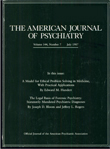TO THE EDITOR: The treatment of opiate abusers by substitution was introduced fairly late in France; high-dose buprenorphine became available in 1996. This synthetic morphinomimetic is a partial µ receptor agonist and a κ receptor antagonist. It binds lastingly to morphine receptors and has a duration of action of at least 24 hours. In France it is used as an analgesic under the trade name Temgesic at a dosage of 0.2 mg. For substitution treatment a high-dosage form is used, marketed under the trade name Subutex. The substitution dosage is between 2 mg and 8 mg.
Because of the ceiling effect, this drug is considered to be particularly safe and has therefore become widely available in general medical practice. It is dispensed at a moderate level of control. Any physician may prescribe buprenorphine in a counterfoil book for up to 28 days. Any pharmacist may supply it. Urine assays can be performed but are not mandatory. However, it is recommended that the prescribing physician seek the advice of physicians in specialized drug abuse treatment centers and of experienced general physicians through a collaborative network. In April 1997, 34,000 patients were being treated with buprenorphine. Nevertheless, some drug abusers, and indeed some physicians, have not complied with the correct practice for prescribing and using this drug. This was not a problem until six deaths linked to misuse of benzodiazepines associated with high-dose buprenorphine were reported. The following postmortem research was conducted on these six cases.
First, the blood and urine were submitted to exhaustive triple screening by immunochemical methods, high-performance liquid chromatography with diode detection, and gas-phase chromatography coupled with mass spectrometry. The combination of all of these methods covers several thousand potentially toxic compounds and allows identification and assay of narcotics (opiates and derivatives, cocaine, amphetamines and derivatives, etc.) together with all of the psychotropics in the pharmacopeia (barbiturates, benzodiazepines, antidepressants, neuroleptics, carbamates, etc.). Other substances tested for included ethanol, volatile solvents, and cyanides (by gas-phase chromatography), carbon monoxide (by carboximetry), digitalis glycosides (by high-performance liquid chromatography/mass spectrometry), and arsenic and thallium (by atomic absorption spectrometry).
Second, buprenorphine and its main metabolite, norbuprenorphine, were analyzed and quantified in all of the autopsy samples (blood, urine, stomach contents, liver, brain, kidney, heart muscle, etc.) by means of a high-performance liquid chromatography/mass spectrometry method described elsewhere (
1).
Blood concentrations of buprenorphine were in the therapeutic range (2.5, 1.1, and 1.7 ng/ml) in three subjects and higher than the therapeutic range (9.0, 12.6, and 17.7 ng/ml) in the other three, relative to known values in nonabusers. The exhaustive screening detected no traces of opiates (morphine, codeine, 6-monoacetylmorphine, etc.) in the postmortem blood. In contrast, all of the subjects displayed therapeutic-range levels of both demethyldiazepam and 7-aminoflunitraz~epam. In all cases these concentrations were fairly low.
The tissue concentrations were markedly higher than the blood levels. The levels of buprenorphine measured in the brain, kidney, and liver were, respectively, three to 12 times higher, one to 33 times higher, and two to 28 times higher than in the blood.
Concomitant use of benzodiazepines seems to be strongly implicated in buprenorphine overdose. This association has been reported in a large number of clinical observations of respiratory depression involving buprenorphine at therapeutic doses (
2,
3), but now this association is shown to be the cause of six deaths. It is necessary to evaluate the risks as precisely as possible by carrying out systematic blood assays of buprenorphine in every case of death of a drug abuser when drug misuse can be suspected and to review, if necessary, the provisions for dispensing high-dose buprenorphine.

